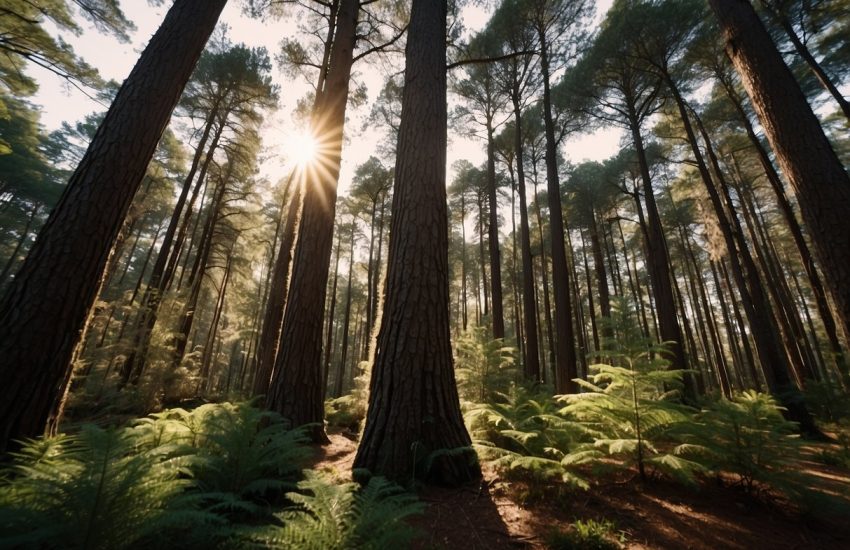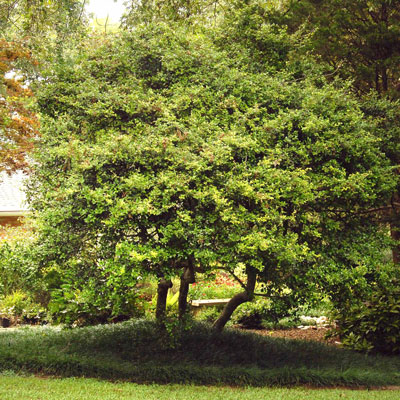Best Evergreen Trees to Grow in Oklahoma
Evergreen plants are those that typically keep the majority of their foliage throughout the winter. There are other evergreen plants, such as junipers with scale- or awl-like leaves and cherry laurel with broad leaves, but when the topic of evergreen trees is brought up, pines, plants from the genus Pinus with needle-like leaves, are frequently cited.
Even while evergreen trees have foliage all year long, not all of their leaves are kept on the tree forever. For instance, three-year-old leaves often fall off of southern magnolia, a broadleaf evergreen, and loblolly pine, a needle-leaf evergreen, each year. The leaves closest to the main trunk are those that are older. Until three, younger leaves farther out on the branch are kept. Although the annual browning and dropping of the oldest core needles can be alarming, it is a regular occurrence.
Evergreen trees give the landscape year-round interest, color, and texture. Providing a structure that can act as a background for other plants can help define the area of your garden. The key to creating a stunning winter garden is this structure. Evergreen trees are incredibly adaptable and can be employed as specimens, hedges, privacy screens, or windbreaks. They can also be utilized as wildlife shelters, reduce noise, and provide shade.
Choose plants that are suitable for your needs carefully because there are so many evergreen trees that may be used in landscaping. The decision should consider some variables, including the intended use, the surrounding environment, and the required level of upkeep.
8 Evergreen Trees to Grow in Oklahoma
The intended use should influence the selection of plants with the proper shape, size, and other physical qualities. Take into account the location and size of the mature trees. Tall trees, like the loblolly pine, are appropriate for larger structures and areas. They frequently overpower or conceal one-story buildings.
Choose more in-scale trees with the Foster Holly tree with red berries in the winter for aesthetic appeal and proper balance with one-story buildings. Construction scale Pruning will only be necessary if the mature size is carefully considered.
The choice of plants should take into account the environment. Important factors include whether the area is sunny or gloomy, moist or dry, exposed to winter winds, or polluted. The chosen plants for Oklahoma should be able to withstand the local climate, including extremes of cold and heat.
Finally, consider how much upkeep the plant will need and any potential drawbacks like vulnerability to disease and insect pests, brittle or softwood easily damaged by wind and ice, large, unsightly, or otherwise bothersome fruits and seeds, and frequent shedding of twigs and small branches.
1. Arborvitae, American or Eastern
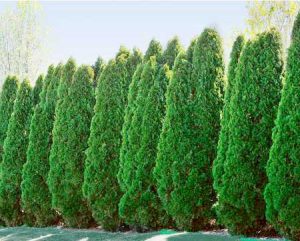
Wide varieties are available. Deep, well-drained soil is ideal for planting; once established, it can withstand heat and drought. Vulnerable to ice, snow, and high winds. Suitable for specimens, screens, and hedges.
Eastern North America is the natural home of the decorative and timber evergreen conifer known as the American arborvitae, sometimes the eastern arborvitae or northern white cedar. It goes by several names in the lumber industry, including white cedar, eastern white cedar, and New Brunswick cedar.
The tree, which may grow to a height of 20 m (65 feet), is the most prevalent and likely the hardiest arborvitae. Sometimes, close to the ground, its trunk forks into several main stems covered in reddish-brown bark. Only four of the eight to ten scales on the cones are typically fruitful. Most cultivated types are slender, densely pyramidal shrubs with intriguing color variations.
2. Giant or Western Redcedar
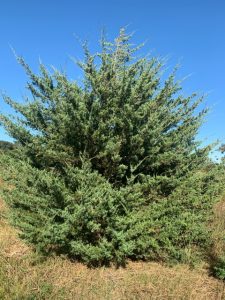
Prefers fertile, well-drained soils that are wet. It can tolerate various pH conditions and naturally thrives near rivers, swamps, and bogs. On dry soils, growth will be stunted.
Thuja plicata, also known as western arborvitae, huge arborvitae, or Pacific red cedar, is a native of the Pacific coast of North America and is a decorative and wood evergreen conifer of the cypress family.
Pyramidal-shaped Western red cedar trees and bushes can be found. When measured above the heavily buttressed base, the trees can reach heights of 60 meters (approximately 200 feet) and circumferences of 6 meters. The inner bark is fibrous, while the outer bark is cinnamon-red or brownish, fissured, and scaly, shedding in irregular flakes.
3. Oriental Arborvitae
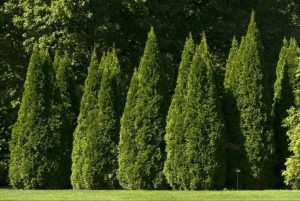
Most soils are tolerated, except those that are very moist; pH is adaptable. Suitable for specimens and hedges.
The Oriental arborvitae resembles other arborvitae species in appearance. This plant may require winter protection. Oriental arborvitae can be planted beneath utility wires because of their ordinarily modest stature. Instead of the species itself, nurseries typically sell this plant's cultivars, which might look very different from one another. Likewise called Thuja orientalis.
4. Atlas Cedar
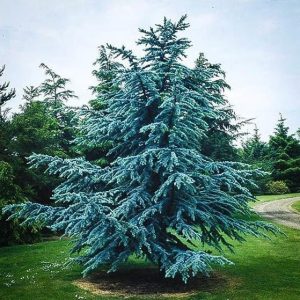
A suitable replacement for Colorado spruce. Available in blue and weeping forms. Semi-dwarf varieties like "Horstmann" grow slowly and mature to a height of 8 to 10 feet and a width of 5 to 6 feet.
The Atlas cedar is a unique evergreen that grows beautifully as a specimen tree. In any setting, its silvery blue to bluish-green needles are striking, and when given the freedom to grow naturally, it takes on an appealing, rugged appearance. The wood from this cedar tree is frequently utilized in chests and furniture drawers because the aromatic oil the tree generates is a natural insect repellent.
5. Italian Cypress
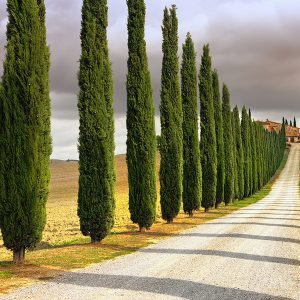
30-foot tall by 2-foot broad columns. The beautiful bark of older trees. Prone to mites and bagworms. Because they are sensitive to cold, plants do best in southern Oklahoma. When properly planted, they spread quickly and require little maintenance.
These cypress trees develop into highly straight, columnar shapes as they grow. Italian cypress can grow to 70 feet (21 meters) or even more. However, they can only reach a width of 3-6 meters or between 10 and 20 feet. Anyone who has grown Italian cypress knows these trees may grow up to 3 feet (9 m) per year in the correct setting.
6. Dwarf Spruce
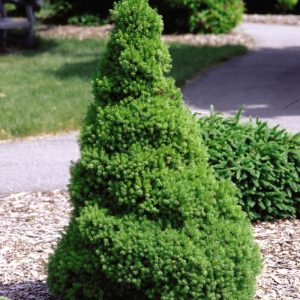
Compact in 30 years to roughly 10 feet. In hot weather, spider mites can be a concern. Better suited to Oklahoma's northern regions. Choose a location away from the hot and dry winds. Prefers sandy loam soil with sufficient irrigation.
The dwarf spruce is an evergreen conifer rarely grows taller than 13 feet and has the traditional pyramidal Christmas tree design. This spruce tree is connected to those that can reach 100 feet or more heights. The most common landscaping usage for dwarf spruce is as a big shrub or small specimen tree throughout America. This tiny variety grows only 2 to 4 inches a year on average. The green, fragrant needles are about half an inch long.
7. Sweetbay Magnolia
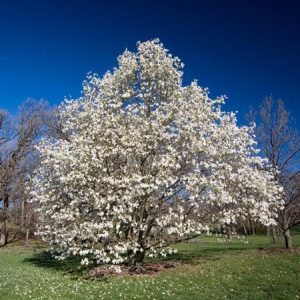
Native to the East. Features waxy, creamy white, cup-shaped flowers that are pleasantly fragrant (lemon), blossoming in the middle of spring and occasionally intermittently during the summer.
The Sweetbay Magnolia has glossy dark green leaves with a silver underside that resembles frosted glass. The 2-3 creamy white flowers bloom in late spring and early summer and have a faint lemon aroma. It has a graceful design and would make a lovely patio or specimen tree. Late summer sees the bright scarlet-red seeded fruit ripen, drawing many birds. Prefers acidic, moist soil in either partial shade or the sun. Grows equally wide and 10 to 20 feet high.
8. Windmill Palm
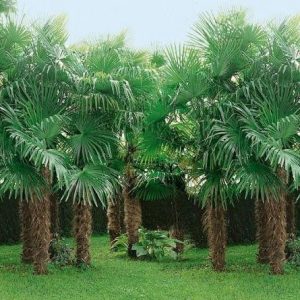
The palm tree has an eye-catching appearance with a lovely, compact crown, enormous, stiff, fan-shaped green foliage, and characteristic hairy black fibers covering its thin, graceful stem. Fantastic for tiny gardens.
The solitary, strong trunk of the windmill palm is covered in hairy, brown fibers. Its windmill-shaped fronds extend from a symmetrical crown and have long, closely-packed, fine-toothed leaves. While some leaf tips are droopy, others remain rigid.
The height of a windmill palm tree can range from 10 to 40 feet. Many households keep them small, with a maximum height of 10 to 20 feet and a spread of 6 to 10 feet. The annual growth rate for windmill palms is less than a foot.
Pick a planting location with well-drained soil that receives some shade. Make sure there isn't too much wind at the location because that could tear the leaves off your hand.
Make a hole twice as wide as the root ball of your windmill palm. You want it deep enough to level the root ball with the dirt around it.
Use a tiny garden spade or your hand gently tease the roots. Make sure the root ball is precisely vertical and not at an angle as you place it in the hole. Make sure there are no air bubbles as you go, backfill the soil, and press it down. As you bury the hole with dirt, soak it.
Put a layer of mulch about 2-3 inches thick on top of the planting area, keeping it far from the stems and trunk. This will aid with moisture retention.
Oklahoma Environment
Homeowners in Oklahoma are frequently searching for quickly growing-trees to add beauty and shade to their gardens. Additionally famous are shrubs, fruit trees, and evergreens. The southern and eastern regions experience warmer, more humid air that is moving north from the Gulf of Mexico.
Compared to the southern regions, these locations have higher humidity, cloudiness, and rainfall levels. Compared to the northern Plains, Oklahoma has longer, hotter summers and shorter, warmer winters. When choosing fast-growing trees for your Oklahoma home landscape, the climate will be a crucial factor.
The right choice of a tree should consider environmental factors as well. Essential features include whether the area is sunny or shaded, moist or dry, exposed to the wind, or polluted.
Always take into account the plant's maintenance requirements, including sensitivity to disease and insect pest attacks, soft or brittle wood that is readily damaged by wind and frost, fruit and seeds that are dirty or bothersome, and heavy leaf and stem shedding.
Conclusion
The sturdy Norway Spruce and the golden Quaking Aspen are ideal for your climate if you live in Oklahoma's cooler mountain regions, where the growing season is shorter, and the summers are moderate. The sweet American Cranberry and the elegant Lombardy Polar will thrive in more moderate climates.
Consider Autumn Blaze or October Glory Maples when you want to add a pop of color to your garden. These trees can resist the colder mountain climates and will illuminate your environment in the fall with their crimson color.
Consider planting a row of Thuja Emerald Green, Cryptomeria Radicans, or Drought Free Evergreens if you wish to boost the privacy of your land. With their year-round dark green color and sense of security, these swiftly growing, feathery evergreens will beautify the boundaries of your property.
Eight mountain ranges and some of the country's most beautiful and untamed terrain can be found in Oklahoma. Trees and bushes come in a wide variety. You may enrich your lovely mountain environment with a combination of hardy shade and blooming trees that thrive in your region. Choose your preferred evergreen to plant in your yard.

